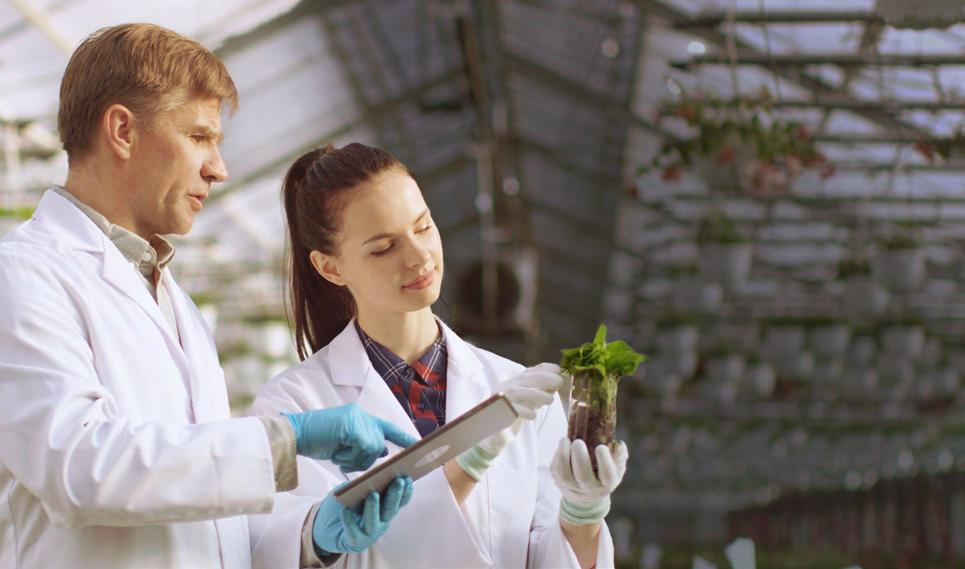
8 minute read
Educating the future food scientist and technologist
Words by Deon Mahoney
According to the United Nations, the world’s population is projected to reach 8.5 billion by 2030. 1 This will require food exporting countries such as Australia to produce ever increasing quantities of food to support global food demand and ensure food security. Most analysts consider that Australia has a tremendous opportunity to grow its agricultural sector, especially in production and further processing of agricultural commodities, and food supply for both our domestic and global markets.
In 2018, the National Farmers’ Federation laid down a bold vision for Australian agriculture, proposing a target value of $100 billion in farm gate output by 2030. In August 2019, the Minister for Agriculture, realising this aspiration, asked the Standing Committee on Agriculture and Water Resources to inquire into the opportunities and impediments to the primary production sectors. The target set for the agribusiness sector of the economy illustrates Australia’s competitive advantage in agricultural production and focuses on the sector producing what the world increasingly needs.
Factors impacting agribusiness in Australia
Various factors will impact Australia’s ability to grow agricultural production and concomitantly expand our food processing capacity. This includes increased access to suitable land, water and irrigation, technology, investment in the value chain, and the availability of a skilled and competent workforce.
A competent and skilled workforce is a key resource. Are our universities and colleges able to produce the quantum of graduates with the knowledge and capabilities required in this rapidly changing world?
In agriculture there is already an identified shortfall in the number of graduates. A select study published by the Australian Farm Institute in 2018 identified an abundance of opportunities for graduates in agriculture and highlighted that the shortfall in availability of graduates was a threat to the sustainability of primary production in Australia. 2
Australian agriculture is also still very much focused on producing bulk commodities for global markets. There are real opportunities to create and manufacture highly segregated and high value-added products for niche markets. However, any optimism surrounding the growth of agribusiness will need to be matched by advances in, and expansion of, our food processing capability and capacity. This requires personnel with advanced skills and vision, and while we enjoy high education levels and an innovative culture, the question remains, can we do it?
Higher education in transition
Investment in education is the key to having a competent workforce, capable of ensuring Australia remains relevant in the third decade of the twenty-first century. Higher education continues to play a vital role in Australian society, making significant contributions socially, economically and intellectually. 3
However, there are significant issues facing this sector. Higher education in Australia is under pressure due to budget cuts, high staff turnover, failure to innovate, market saturation in specific disciplines, changes in delivery mechanisms and the changing job market.
Employers of today are seeking employees with the most up-to-date
Higher Education Statistics in Australia
Persons in Australia aged between 25-34 with a bachelor’s degree (or higher)
Australian and international student enrolments
Higher education graduates
Education of international students in Australia 39.7%
1.4 million (2017)
340,000 (2017)
3rd largest export (behind iron ore and coal)
skills and knowledge. The education provider needs to become more consumer driven. For example, innovative digital technologies and emerging business models are changing the nature of the food industry and supply chains, with these new technologies impacting the value of existing products and services offered in the industry. Graduates need to be well-informed of contemporary trends and processes and suitably equipped to support the food industry to address the challenges ahead.
Skills required in agribusiness
Higher educational programs in agriculture, food science and food technology have experienced significant change and have continued to evolve over the past thirty years. The number of institutions presenting food science and technology degrees and food science related programs has increased significantly in this time.
Currently, there are around 22 institutions delivering programs related to food science and technology, ranging from certificate, diploma and undergraduate degree level to postgraduate degree level. But are enough students that are interested in careers in food science and technology being secured, to remain viable? With constant budgetary pressure on these institutions, failure to attract enrolments in programs can result in programs being either inadequately resourced or even axed.
The educational providers also need to continually overhaul their programs to reflect the skills, challenges, and multi-disciplinary competencies needed to support agribusiness and to ensure graduates retain their relevance and currency. Attracting students to enrol in these programs continues to be a challenge.
Do we adequately promote the complex but exciting and challenging career in agriculture or food science? Are existing programs sufficiently interesting and innovative to attract students from high school into university programs in food science? Regrettably, statistics on enrolments and performance are surprisingly difficult to find and interpret. 4
However, one statistic is clear - enrolment of overseas students is booming and their fees are the single largest source of university revenue.
A diverse range of skills are required for a career in agribusiness or food science. These include inputs from disciplines such as biology (microbiology, botany, zoology and entomology), agronomy, plant pathology, water science, animal husbandry, veterinary science, food science and technology, quality assurance, engineering, laboratory methods, fermentation science, molecular biology, nutrition, and so on. The capacity to cover all these disciplines in a single faculty or department is challenging and requires academics who can cover cross-disciplines and create alliances with other facilities.
The food scientist of the future will need to address drivers such as increasing demand for higher value foods, increasing ethical considerations regarding the origin of our foods and sustainable production, and increasing demand for specific food attributes (health benefits along with safety, security and freshness). Different sectors of the Australian food industry will face different challenges and different drivers for change.
In addition to graduates that will operate and manage our food processing facilities, ensure product safety and suitability, and create innovative new products, there is a need for researchers that will undertake the fundamental research that will underpin expanding food production and its utilisation.
Investment in research and development
A wide range of entities fund research and development in Australia. In addition to the benefits that accrue from undertaking strategic research, there is the training of our next generation of researchers whose outputs ensure our food industry is both innovative and competitive.
Competitively funded collaborative research centres such as the Australian Research Council (ARC) Centres of Excellence and Cooperative Research Centres (CRC) are a key feature on the Australian landscape as they bring together experts from research organisations, universities, industries and government and produce world-leading research with real-world benefits. The outcomes of their work result in productivity improvements, drive job creation and lead to benefits for Australian society.
In 2019, the ARC announced the establishment of the Centre of Excellence for Plant Success in Nature and Agriculture, based at The University of Queensland. This Centre will investigate the adaptive strategies underpinning productivity and resilience in a range of diverse plants. Improving knowledge of the genetic and physiological traits of plants will provide breeders with predictive capability to improve strain quality. It will also support predictions on plant varieties suited to particular environments and enable farmers to choose which plants to grow, and in what areas for each season for the best yield. The results will have
specific application to issues around food security and climate change.
The Future Food Systems CRC was also established in 2019. It will support participants in optimising the productivity of regional and peri-urban food systems, taking new products from prototype to market and implementing rapid, provenanceprotected supply chains from farm to consumer. The CRC initiated by the NSW Farmers Association, UNSW and Food Innovation Australia Ltd and working with its research partners, will cover the entire food supply chain, incorporating innovations in protected cropping, advanced manufacturing, smart logistics and food science, to underpin high-value industries in agri-food hubs. The CRC will assist in graduating 60 PhD students, helping to train a new generation of scientists.
Other CRCs include the Fight Food Waste CRC which aims to improve the competitiveness, productivity and sustainability of the food industry, and the Food Agility CRC which is leading a digital revolution in food production and supply, supporting the agri-food sector to be more globally competitive and sustainable.
Summary
Our future diet may very well include less dairy, seafood and meat. Instead we will have customised diets comprising a range of hitherto underutilised or novel ingredients and created using new technologies.
Critical to us expanding Australian food production and utilisation is an educated and dynamic cohort of food scientists and technologists. Graduates and their skills are one of the most important success factors for the Australian food industry as it approaches the future.
We need graduates with diverse skills and determination in order to support the transformation of agricultural production into value-added products that meet contemporary market needs. Our higher education institutions need to continue to evolve, creating courses which meet these needs, and we must continue to invest in competitively funded collaborative research centres.
References
1. https://www.un.org/sustainabledevelopment/ blog/2015/07/un-projects-world-population-toreach-8-5-billion-by-2030-driven-by-growth-indeveloping-countries/ 2. J. Pratley and N. Crawley (2018). Graduate
Destinations in Agriculture. Australian Farm
Institute http://www.farminstitute.org.au/
LiteratureRetrieve.aspx?ID=161441&A=SearchRes ult&SearchID=10438474&ObjectID=161441&Objec tType=6 3. https://www.universitiesaustralia.edu.au/wpcontent/uploads/2019/06/Data-snapshot-2019-
FINAL.pdf 4. Norton, A., Cherastidtham, I., and Mackey, W. (2018). Mapping Australian higher education 2018. Grattan Institute https://grattan.edu.au/ wp-content/uploads/2018/09/907-Mapping
Australian-higher-education-2018.pdf
Deon Mahoney is head of Food Safety for the Produce Marketing Association Australia and New Zealand (PMA A-NZ), and has previously worked for the World Health Organisation, the Food and Agriculture Organisation and FSANZ. f

For more information Visit: bsigroup.com/food-au Call: 1300 730 134 Is your palm oil sustainable?
The palm oil supply chain is complex and the consumer-driven demand for sustainable palm continues to grow. RSPO Supply Chain Certification with BSI can help your organization increase resilience in this challenging market and assure customers that your palm oil practices are sustainable.
From mills and crushers to refineries and ingredient or end-product manufacturers, the certification process assesses the traceability of your product as well as your procedures so that you can credibly claim it aligns with environmental and social best practice as established by the Roundtable on Sustainable Palm Oil (RSPO).
Certified organizations benefit from being able to use RSPO trademarks on B2B and B2B2C communications and the ability to position themselves as a supply chain-certified supplier to potential and existing downstream customers who are looking for certified suppliers as part of their own RSPO certification process.










